Day 3 Out of the Deep… (Written on June 03, 2013)
It’s just after midnight and a very, very black sky cleverly hides all celestial bodies. We are heading 099 degrees and just south of Denmark, Western Australia. At first we are alone on our journey, but soon three “comets” appear on the 96 nm RADAR. Really the “comets” are vessels shown as red blobs with attached black tails indicating the ships’ movement over the previous 15 minutes– indeed we have company here in the blackness. Pedhoulas Commander, one of the ships, a mid-sized one at 229m long has a CPA (Closest Point of Approach with us) of 2.55 nm in 3 hours time. The AIS reports it will be somewhere exotic, Cigading at 0300 on the 10th of June… crazy! To be safe, and to keep the mind occupied, I track the ships on both AIS and ARPA.
On the navigation chart shipping is represented by blue lines from the AIS (Automatic Information System) signal, “comets” on the RADAR and lights seen out of the wheelhouse windows represent small worlds travelling around the world. Ships full of men leaving wives and children seeking a modern day fortune in what was once called the “Merchant Navy”.
There is a green light towards West Cape Howe – also the name of a favourite local WA winery adorned with an alluring seahorse label. Another vessel begins to travel towards our stern as we make approaches towards Albany and the surrounding area. This area is stunning, huge granite boulders line white beaches with wild southerly winds and swirling swells. I peel back the black to think of it in daylight.

Whitecaps punctuate the blue sea but the surface is relatively flat, since there is little to no swell. We have 18-20 knots of Easterly wind which makes spray and mist on the wheelhouse windows but soon this turns to real rain and the six front windows stream with lines of rain drops. Again the one hundred percent or 8/8 oktas of cloud cover gives the sea a soft grey hue. Flesh-footed shearwaters skim the wave-tops and 500m out an albatross glides effortlessly.
We are ever-hopeful for cetacean sightings and in 812m of water Curt comments “Ok, we are in sperm whale country now and killer whales too”. Our eyes are peeled for bushy left-angled blows and tall, dark dorsal fins.
The rain clears momentarily and the wind drops to 7-10 knots – these are ideal sighting conditions as the air is “clean and clear”, we must find a whale… The sea radiates gorgeous silver tones, turning dark purple at the horizon reflecting the prevalent and solid cumulonimbus clouds. By midday with a delicious lunch of baguettes, ham, salami, tasty cheeses, garden salad and steaming fried rice we are in 3225 m of water in the Wilyuna Canyon, south of Cape Knob. We are heading East cutting a great swathe across the Southern Ocean. On the edge of the drop-off the screens show the bathymetry falling away as we progress, it’s getting deeper…
Meanwhile, our Bird Observations each hour have included three Cape Petrels of vivid black/white markings on the topside of their wings which have been continuously circling our vessel. They duck and weave so quickly they appear as a childs’ kite and with a practice I am able to get good id-shots of their unusual under and over wing patterns.
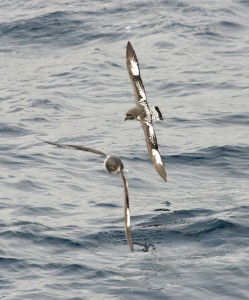
Cape Petrels with stunning black/white upper wing coloration duck and weave over the waves like a childs’ kite. Photo credit M.Jenner
At 1445 I mutter semi-quietly since Curt is resting, “Hey, I’ve got a blow, it’s left-angled, it’s a sperm whale!” Hesitating only for a mere moment I knock on our door to wake Curt, “Curt, sorry to wake you, we have a whale, certain a sperm…” We have perfect sighting conditions, and as Inday and I get ourselves on deck with our gear I count the blows. “Three, oh – I need my jacket, Four, it’s heading 170 degrees relative to us, Five, wow it’s big, ok, now we are at Six blows…” You got it – there is on-going commentary and chatter as looking through my 400m lens I can see very clearly that we have a huge, male sperm whale in front of us! Curt stumbles out of our cabin, putting on his shoes and fleece and after checking the nav computer he comes outside to drive Whale Song from the starboard Portuguese bridge steering station. The brisk, early afternoon air wakes him quickly.
Counting the blows we see an 18m animal, a large male with a massive, square head. The rounded bushy blow is angled to the left due to the physical nature of their single asymmetrical blowhole, which creates an extremely recognisable surfacing style. Ten blows are noted and then after a gap of approximately 2 minutes, the animal continues blowing from the surface. Stooging along slowly, the whale exhales and consistently remains on the water surface allowing the blowholes and dorsal fin to be seen simultaneously.
This is a huge animal! “Sixteen blows, wow, what a great blow, Seventeen, this whale will be down for a long-time soon, Eighteen, oh, here it goes, look at the caudal peduncle – its’ going down, oh it’s Fluking Up!” Chic-chink ,chic-chink, chic-chink goes my shutter and 81 shots later we have the surfacing and fluke up sequence of an adult male sperm whale in the southern part of the Bremer Canyon in the Great Australian Bight! Yahoo!
We spent twenty-three minutes with this sperm whale which was swimming in 4000m of water recording a SST (Sea Surface Temperature) of 16.0 0C, the temperature at depth naturally much cooler. Cool, nutrient-rich waters provide a perfect environment for desirable giant squid for which this animal can dive, foraging for up to 2 hours duration at depths of 3000m! The deep water is alive.
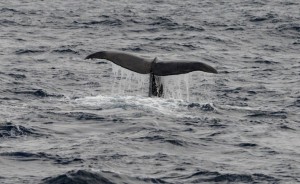
Huge, broad flukes of a sperm whale rise as it sounds – its’ dive as deep as 3 km. Photo credit M.Jenner
Curt fired up the acoustic system and immediately upon completion of our surface observations with the tell-tale “I-will-be-down-for-a-while” Fluke-Up Dive, two sonobuoys were deployed to collect the physical components of the foraging sounds of this male sperm whale. Across the screens multiple parallel lines match the criuh criuh criuh sounds that are audible in real-time. Ranging from 1000Hz to 15,000Hz this animal is hunting for squid, sounding the water and every now and then, an extra loud series appears to indicate possible prey or even a successful catch. The recording continues for one hour and the main saloon, aka sound lounge, is filled with the real-time codas of a sperm whale! This is totally intriguing and fascinating!
Sunsets thus far have been a tad thwarted with the heavy cloud but the “God-cloud” just before the expected sunset is still interesting. Over dinner made by new galley help Dale (now-turned Narrator), as we munch on yummy “man-burgers” (hamburgers without bread), warmed buttered asparagus and delicious fried potatoes, we also savour our afternoon with a sperm whale rising from the deep to be seen at the surface and then returning to the deep to be heard on the acoustic equipment…
With a deep appreciation for what comes from down below,
Mich

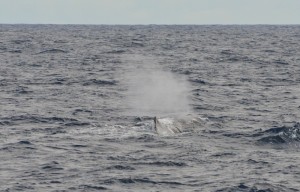



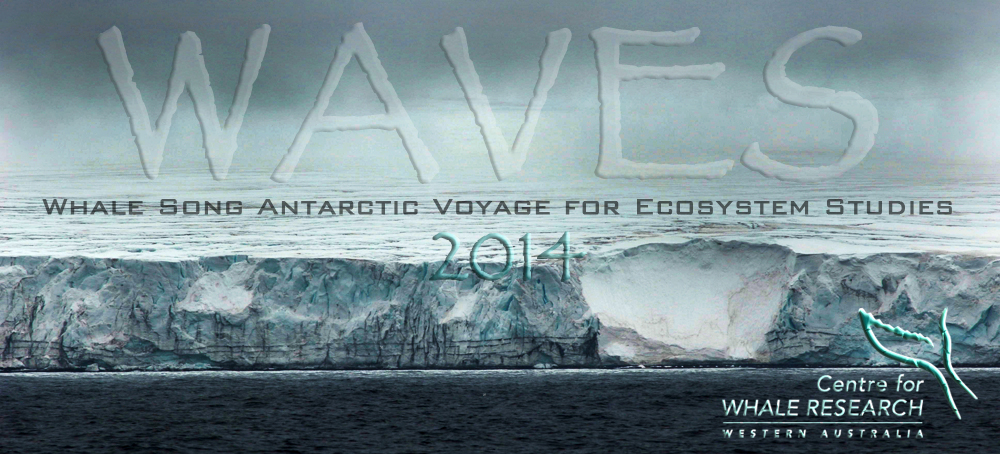










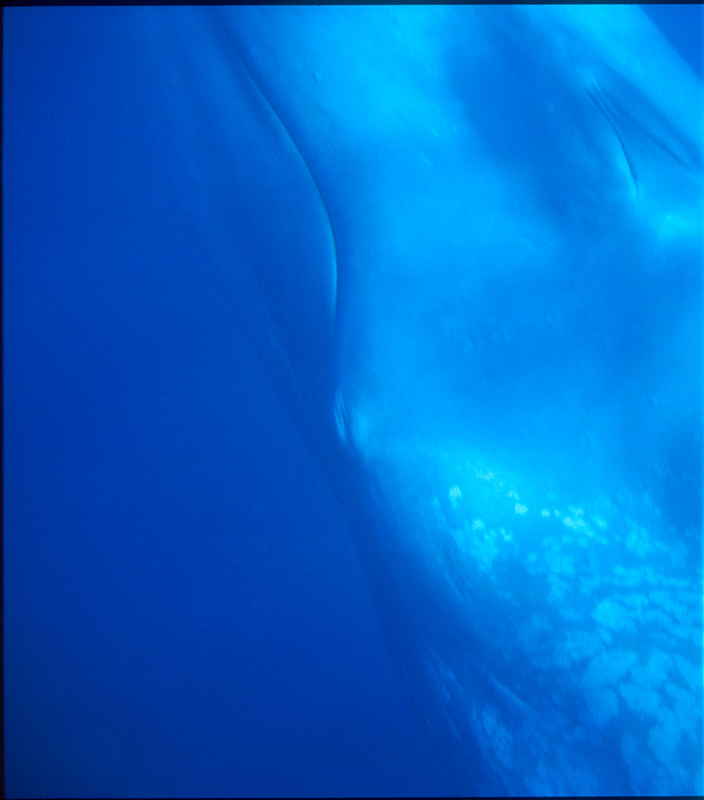
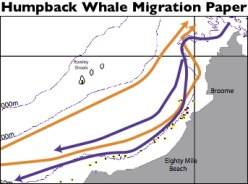
No comments yet.